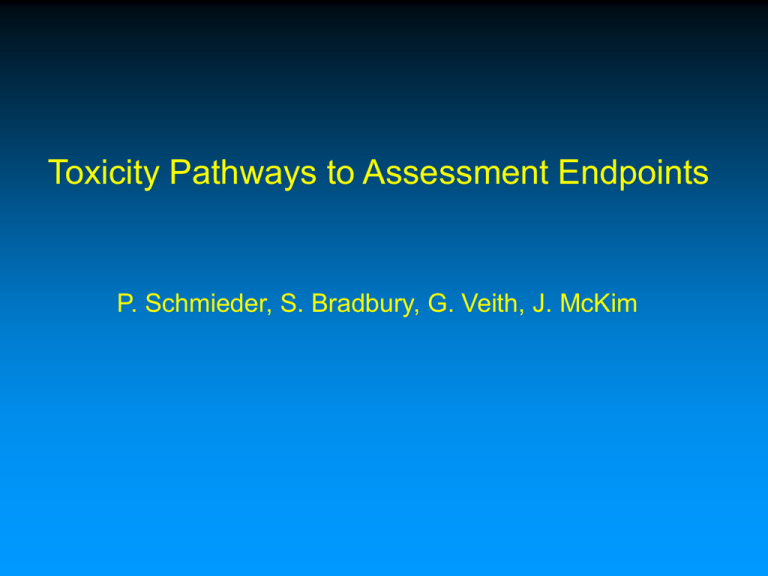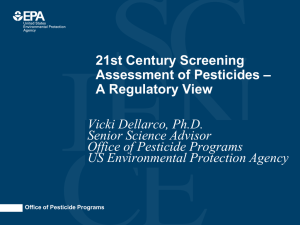
Toxicity Pathways to Assessment Endpoints
P. Schmieder, S. Bradbury, G. Veith, J. McKim
Toxicity Pathway
WHAT:
•
A concept; a way of depicting a chain of events starting with a molecular
initiating event (site of chemical –biological interaction) and ending with an
adverse effect manifested in an individual, or higher level – population,
community, ecosystem
•
May include a biochemical/signaling pathway, but goes beyond, to at least
hypothesize how something observed at one level of biological
organization is linked to response manifested at another level.
WHY:
•
Chemical similarity is defined in the context of biological similarity
– “Similar” chemicals, by definition, invoke the same toxicity pathway
(within a specified biological model)
– QSARs are developed for “similar” chemicals from a known or
hypothesized “mode/mechanism” of action; hypothesis is tested to
refine the models
•
QSAR requires a well-defined biological system
Effects of toxicants occur at different levels of biological
organization. Toxic effects are best known and understood at
the cell and organ level, while the ecosystem and community
level are least understood although most relevant.
(Haux and Forlin, 1988)
Ecosystem
Productivity
Energy Flow
Community
Contaminant
dynamics in
microcosms
Population
Chronic
toxicity
Reproduction
Growth
Individual
Acute toxicity
Lethal
Sublethal
Understanding
Relevance
Organ
Respiration
Osmoregulation
Cell
Structural
changes
Induction
TOXIC
CHEMICAL
Toxicity Pathway Uses
• Assess knowledge gaps - what we know and what we don’t know
about a chemical’s toxicity (toxicodynamics)
• Assess the plausibility that a series of events are linked, i.e., degree
of connectedness;
– degree of specificity/certainty needed depends upon intended use
• prioritization for further testing – correlation; “good” hypothesis?
• quantitative RA - confirm cause and effect?
• Pinpoint molecular initiating event for chemical extrapolation
– QSAR – can be based on in vivo endpt if system is simple enough,
e.g., fish acute/chronic for narcotic chemicals where applied chem conc
is directly related to chemical activity in blood and further to the whole
organism effect
– Measurements closer to molecular initiating event will be more
definitive for QSAR but some degree of relevance should be
established (Linkage across levels of biological organization)
• Basis for species extrapolation
• Shifting RA paradigm - predict most likely tox pathways for a
chemical to pinpoint most appropriate testing
Well-Defined Biological System
(Know what you know and what you don’t know)
• Metabolism
– Is the system used for collection of empirical data
capable of xenobiotic metabolism?
– Is what you’re measuring due to parent chemical or a
metabolite?
• Kinetics
– What do you understand about the chemical kinetics
within the system?
– Is the chemical in solution
• Bound and unavailable
• Loss to hydrolysis
Measure chemical form and concentration in your system
Log Fahead Minnow Molar Toxicity (1/LC50)
0
-2
-4
-6
-8
-2
0
2
Log P
4
6
Log Fathead Molar Toxicity (1LC50)
Fathead Minnow Acute Toxicity Database
0
Narcosis I
-2
Narcosis III
-4
Narcosis II
Uncoupler
-6
-8
-10
-2
0
2
Log P
4
6
8
Sorting Modes of Action
(Toxicity Pathways)
Fish Acute Toxicity Syndromes
- respiratory/cardiovascular responses (RBT)
Behavioral observations (FHM)
Mixture studies (FHM)
Nonpolar Narcotic Toxicants
LC50-96hr
MATC-30 day
Water Solubility
Log Molar Concentration
0
-1
-2
-3
-4
-5
-6
-7
0
1
2
3
Log P
4
5
6
Delineating Toxicity Pathways Across Levels of Biological Organization:
Acute Nonpolar Narcosis
Assigning Chem
Toxicol. Similarity
for QSAR
In vivo Assays
Xenobiotic
MOLECULAR
TARGETS/RESPONSES
Membrane
Partitioning
TISSUE/ORGAN SYSTEM PHYSIOLOGY
-Decreased Respiration
-Decreased Circulation
Ion Gradient
Interruption
INDIVIDUAL
Lethality
-Faulty Osmoregulation
Failed ATP
Production
Toxicological
Understanding
Risk Assessment
Relevance
Uncoupling Toxicants
Log Molar Concentration
2
Water Solubility
LC50-96hr
MATC-30 day
0
LC50-96hr
-2
-4
MATC-30 day
-6
-8
-2
0
2
4
Log P
6
8
Delineating Toxicity Pathways Across Levels of Biological Organization:
Acute Uncoupling of Oxidative Phosphorylation
Assigning Chem
Toxicol. Similarity
for QSAR
In vivo Assays
Xenobiotic
MOLECULAR
TARGETS
Chemical
Partitioning
Membrane
Proteins/
Ion Channels
Toxicological
Understanding
TISSUE/ORGAN SYSTEM PHYSIOLOGY
INDIVIDUAL
-Increased Respiration
-Increased O2 Consumption
Lethality
-Decreased O2 Utilization
Risk Assessment
Relevance
Reactive Toxicants
LC50-96hr
MATC-30 day
Water Solubility
Log Molar Concentration
0
-1
-2
-3
-4
-5
-6
-7
-8
0
1
2
3
Log P
4
5
6
Sorting Modes of Action
(Toxicity Pathways)
Fish Acute Toxicity Syndromes
- respiratory/cardiovascular responses (RBT)
Behavioral observations (FHM)
Mixture studies (FHM)
Biochemical responses – in vitro
Effects of toxicants occur at different levels of biological
organization. Toxic effects are best known and understood at
the cell and organ level, while the ecosystem and community
level are least understood although most relevant.
(Haux and Forlin, 1988)
Ecosystem
Productivity
Energy Flow
Community
Contaminant
dynamics in
microcosms
Population
Chronic
toxicity
Reproduction
Growth
Individual
Acute toxicity
Lethal
Sublethal
Understanding
Relevance
Organ
Respiration
Osmoregulation
Cell
Structural
changes
Induction
TOXIC
CHEMICAL
Defining Toxicity Pathways Across Levels of Biological Organization:
Redox cycling_Arylation
Assigning Chem
Toxicol. Similarity
for QSAR
Xenobiotic
In vitro Assays
In vivo Assays
CELLULAR
MOLECULAR
Binding to
cytoskeletal
components
-Redox cycling
- SH Arylation
Toxicological
Understanding
GSH Oxidation
PrSH Oxidation
ROS Production
Decr. Energy Chg
Disrupt Cytoskel.
(MT;IF);
Blebbing
Altered Cell
Signaling
Cell Death
TISSUE/ORGAN
Liver Toxicity
Multiple Organ
System
Toxicities/Disease
INDIVIDUAL
Lethality
Impaired
Growth
Risk Assessment
Relevance
Chemical Class is not MOA for Industrial Chemical Acute Tox
Chemical Class
Non-halogenated alkanes
Narcosis I
6
Halogenated alkane/enes
25
Narcosis II
Ethers
23
Alcohols
55
Aldehydes
39
Ketones
47
AChE Inhibition
Nitriles
15
Aliphatic amines
6
Respiratory Inhibition
Aromatic amines
31
Azides
Electrophile/proelectrophile
Reactivity Mechanisms
2
Sulfides/thiols
12
Benzenes
CNS Seizure Mechanisms
21
Phenols
37
Nitro-ring
28
5-Membered ring
9
Hetero atom
6
1
Anilides/ureas
Phosphates
5
4
Pesticides
Pharmaceuticals
0
Oxidative Phosphorylation
Uncouplers
31
Esters
Sulfur compound
Narcosis III
28
9
10
20
30
40
Number of Chemicals
50
60
Knoxville Workshop Framework for
Predicting Reactive Toxicity
Speciation
Parent
Chemical
and
Molecular
Initiating
Events
Measurable
System
Effects
Adverse
Outcomes
Metabolism
Rather than developing statistical models of complex endpoints,
molecular initiating events are identified as well-defined QSAR
endpoints…..and used to estimate the probabilities for important
downstream biological effects based on transparent
assumptions
Steps to the Development of QSAR for
Reactive Toxicants
Speciation
Parent
Chemical
Molecular
Initiating
Events
and
Measurable
System
Effects
Adverse
Outcomes
Metabolism
QSAR
Systems
Biology
1. Establish Plausible Molecular Initiating Events
2. Design Database for Abiotic Binding Affinity/Rates
3. Explore Correlations/Pathways to Downstream Effects
4. Explore QSARs to Predict Initiating Event from Structure
Delineation of Toxicity Pathways
Linkages Across Levels of Biological Organization
In Silico Methods
Electronic
Chemical
Reactivity
Profiles
Molecular
Receptor binding
DNA alteration
Proteins adducts
Membrane effects
In vitro Methods
Cellular
Gene Activation
Protein Syn/deg
Cell Signaling
GSH balance
In vivo Methods
Organ
Individual
Respiration
Osmoregulation
Liver Function
Gonad Devel
Lethality
Growth
Development
Reproduction
Understanding “Specific” Toxicities
Endocrine Disruptors:
-Receptor-Mediated Toxicity Pathways
ER, AR, TR?
-Enzyme Inhibition (aromatase)
-Steroidogenesis (altered steroid metab)
Delineating Toxicity Pathways Across Levels of Biological Organization:
Direct Chemical Binding to ER
QSAR
Xenobiotic
MOLECULAR
ER
Binding
Toxicological
Understanding
In vivo Assays
In vitro Assays
CELLULAR
Altered
Protein
Expression
TISSUE/ORGAN
Altered
Hormone
Levels,
Ova-testis
INDIVIDUAL
Chg 2ndry
Sex Char,
Altered
Repro.
POPULATION
Skewed
Sex
Ratios,
Altered
Repro.
Risk Assessment
Relevance
Xenopus Metamorphosis Model for
Molecular
Thyroid System Disruption
Cellular
Gene/Protein
Expression
Hypothalamus
TRH (CRH) Release
Circulating TH Status
Pituitary
Gland
TSH Release
Tissue
Thyroid Histology
Thyroid Gland
Thyroid Hormone
Synthesis
Individual
Altered Morphology
Peripheral
Tissues
Deiodination
Morphology
Conceptual Overview of Project
Increasing Diagnostic
(Screening) Utility
Levels of
Biological
Organization
Small teleost model,
well characterized
genome, low
ecological /
regulatory relevance
Molecular
•Gene expression
•Protein levels
•Receptor binding
•Enzyme activities
Cellular
Organ
Individual Population
Alterations in
•Functional changes
production of
Altered reproduction Decreased numbers
•Structural changes
signalling molecules
or development
of animals
(Pathology)
Phase 2.
Zebrafish
genomics
proteomics
Computational
modeling
Small teleost model,
poorly characterized
genome, high
ecological /
regulatory relevance
Increasing Ecological
Relevance
HPG Systems modeling
Phase 3.
Phase 1.
Fathead minnow
molecular markers
metabonomics
Fathead minnow 21 d reproduction test
→’s Depict the flow of information
Population
modeling
Chemical Risk Assessments
Linkages Across Levels of Biological Organization
Receptor-Mediated Pathways
Chemical 2-D
Structure/
Properties
Organ
Molecular
Receptor/
Ligand
Interaction
Chemical 3-D
Structure/
Properties
Metabolism
Cellular
Gene
Activation
Protein
Production
Understanding
Relevance
Gonad
Development
(Ova-Testis)
Altered Hormone
Levels
Impaired Kidney
Function
Individual
Impaired
Reproduction
Toxicokinetics
Toxicodynamics
In vivo
Xenobiotic
Chemical
Molecular/
Sub-Cellular
ChemicalReceptor
Binding
Initiating
Altered
Gene/Protein
Expression
Toxicological
Understanding
Cell
Changes in
Gene/Protein
Expression
Leading to
Altered Cell
Function
Organ/Tissue
Individual
Altered
Organ
Growth and
Function
Impaired
Reproduction
Risk Assessment
Relevance
Chemical Kinetics
In vivo
Xenobiotic
Chemical
Toxicological
Understanding
Molecular/
Sub-Cellular
Cell
Receptor
Binding
Gene/Protein
Gene/Protein
Expression
Cell
Function
Organ/Tissue
Individual
Growth and
Function
Reproduction
Risk Assessment
Relevance
Chemical Kinetics
Xenobiotic
Chemical
In vivo
Uptake
Molecular/
Sub-Cellular
Cell
Organ/Tissue
Individual
Trout
Toxicological
Understanding
Risk Assessment
Relevance
Chemical Kinetics
Xenobiotic
Chemical
In vivo
Distribution/Metabolism
Molecular/
Sub-Cellular
Cell
Organ/Tissue
Uptake
Individual
Trout
Toxicological
Understanding
Risk Assessment
Relevance
Chemical Kinetics
Xenobiotic
Chemical
In vivo
Distribution/Metabolism/Excretion
Molecular/
Sub-Cellular
Cell
Organ/Tissue
Uptake
Individual
Trout
Toxicological
Understanding
Risk Assessment
Relevance
Metabolism studies across levels of biological organization
Linkages must be established
Xenobiotic
Chemical
In vitro
In vivo
Distribution/Metabolism/Excretion
Molecular/
Sub-Cellular
Microsomes
S9
Purified
enzymes
Toxicological
Understanding
Uptake
Cell
Organ/Tissue
Individual
Isolated
Hepatocytes
Isolated
Perfused
Liver
Trout
Celllines
Tissue
Slices
Risk Assessment
Relevance
Metabolism of Estradiol
Rainbow Trout Liver Slices vs RTH149 Cells
100
Slices: Ethylacetate Fraction (E2)
Slices: Aqueous Fraction (E2-gluc)
RTH149 Cells: Ethylacetate Fraction (E2)
RTH149 Cells: Aqueous Fraction(gluc)
80
3
Percentage of Maximum H-Estradiol
120
60
40
20
0
0
4
8
12
16
Time (h)
20
24
28
Chemical Kinetics
Xenobiotic
Chemical
In vivo
Distribution/Metabolism/Excretion
Molecular/
Sub-Cellular
Toxicological
Understanding
Cell
Receptor
Binding
Gene/Protein
Expression
Gene/Protein
Expression
Cell
Function
Uptake
Organ/Tissue
Individual
Growth and
Function
Reproduction
Risk Assessment
Relevance
Project Goal: Enhance Metabolic Simulator for EPA Regulatory Lists
OPP Chemicals
Existing ER
Binding Model
Existing Metabolism
Simulator
Predicted Metabolites
Expert Judgement
improve
ER model
Verified ER
Prioritized Chemicals
activation
Verified maps
Trout
liver slice
MED; NERL-Athens; LMC
Predicted inactive
parent;
“activated”
metabolites
Analytical
methods
Rat
liver microsomes,S9
Toxicity Pathways
A useful concept for organizing toxicity data across levels of
biological organization
-Linking toxicological understanding to risk assessment
relevance
A conceptual framework for:
- chemical extrapolation
- molecular initiating events are the key to linking
chemical reactivity continuum to biological
response continuum
- species extrapolation
A useful concept in Predictive Toxicology
- Predict most likely tox pathway for a chemical to
pinpoint most appropriate testing
Structure
Chemical 2-D
Structure
Structure
Chemical 2-D
Structure
Structure
Chemical 2-D
Structure
Structure
Chemical 2-D
Initiating Events
Structure
Structure
Molecular
Chemical
3-D
Structure/
Properties
ER Binding
Molecular
Chemical
3-D
Structure/
Properties
ER Binding
Molecular
Chemical
3-D
Structure/
Properties
ER Binding
Molecular
Chemical
3-D
Structure/
Properties
ER Binding
Molecular
2-D
Structure
StructureChemical
ER Binding
Chemical
3-D
Structure/
Properties
Molecular
Chemical
Structure
Molecular
Chemical 2-D
Structure
2-D
Structure
Structure
Chemical
2-D
Structure
Structure
Chemical 2-D
Structure
Chemical
3-D
Structure/
Properties
ER Binding
ER Molecular
Binding
Chemical
3-D
Structure/
Properties
ER Binding
Molecular
ER Binding
Chemical 3Chemical
3-D
Structure/
Properties
D Structure
Molecular
2-D
Structure
Structure/ Chemical
ER Binding
Chemical
3-D
Structure/
Properties
Properties
Structure
Chemical 2-D
Structure
Structure
Chemical 2-D
Structure
Structure
Chemical 2-D
Structure
Structure
Chemical 2-D
Structure
Structure
Chemical 2-D
Structure
Structure
Chemical 2-D
Structure
Molecular
Chemical
3-D
Structure/
Properties
ER Binding
Molecular
Chemical
3-D
Structure/
Properties
ER Binding
Molecular
Chemical
3-D
Structure/
Properties
ER Binding
Molecular
Chemical
3-D
Structure/
Properties
ER Binding
Molecular
Chemical
3-D
Structure/
Properties
ER Binding
Molecular
Chemical
3-D
Structure/
Properties
ER Binding
Cellular
ER
Transctivation
Organ
Vitellogenin Induction
Individual
Altered
Cellular
ER
Transctivation
Organ
Vitellogenin Induction
Individual
Altered
Cellular
ER
Transctivation
Organ
Vitellogenin Induction
Individual
Altered
Cellular
ER
Transctivation
Organ
Vitellogenin Induction
Individual
Altered
Cellular
ER
Transctivation
Organ
Vitellogenin Induction
Individual
Altered
Cellular
Cellular
ER
Transctivation
Organ Individual
Organ
Altered
Vitellogenin Induction
Reproduction/
VTG mRNA
VTG mRNA
VTG mRNA
VTG mRNA
VTG mRNA
VTG mRNA
ER
Cellular
Transctivation
ER
Transctivation
VTG mRNA
Sex Steroids
Sex Steroids
Sex Steroids
Sex Steroids
Sex Steroids
Reproduction/
Development
Reproduction/
Development
Reproduction/
Development
Reproduction/
Development
Reproduction/
Development
Sex Steroids
Vitellogenin
Development
InductionIndividual
Organ
Altered
Vitellogenin Induction
Reproduction/
Sex Steroids
Development
Cellular
VTG
ER mRNA
Transctivation
Sex Steroids
Individual
Organ
Altered
Vitellogenin Induction
Reproduction/
Cellular
ER
Transctivation
Organ
Vitellogenin Induction
Individual
Altered
Cellular
ER
Transctivation
Organ
Vitellogenin Induction
Individual
Altered
Cellular
ER
Transctivation
Organ
Vitellogenin Induction
Individual
Altered
Cellular
ER
Transctivation
Organ
Vitellogenin Induction
Individual
Altered
Cellular
ER
Transctivation
Organ
Vitellogenin Induction
Individual
Altered
Cellular
ER
Transctivation
Organ
Vitellogenin Induction
Individual
Altered
Cellular
ER
Transctivation
Organ
Vitellogenin Induction
Individual
Altered
VTG mRNA
VTG mRNA
VTG mRNA
VTG mRNA
VTG mRNA
VTG mRNA
VTG mRNA
VTG mRNA
Sex Steroids
Sex Steroids
Sex Steroids
Sex Steroids
Sex Steroids
Sex Steroids
Sex Steroids
Sex Steroids
Development
Reproduction/
Development
Reproduction/
Development
Reproduction/
Development
Reproduction/
Development
Reproduction/
Development
Reproduction/
Development
Reproduction/
Development
Libraries of Toxicological Pathways
Individual
Altered
Reproduction/
Development
Impaired Reproduction/Development
Mapping Toxicity Pathways to Adverse Outcomes
Mapping Toxicity Pathways to Adverse
Structure
Individual
Cellular
Molecular
Organ
Outcomes
Chemical
2-D
ER
Altered
Structure
Vitellogenin Induction
Transctivation
Reproduction/
ER Binding
Development
Sex Steroids
VTG mRNA
Structure
Structure
Chemical 2-D
Structure
Structure
Chemical 2-D
Structure
Structure
Chemical 2-D
Structure
Structure
Chemical 2-D
Initiating Events
Structure
Structure
Chemical 2-D
Structure
Structure
Chemical 2-D
Structure
Structure
Chemical 2-D
Structure
Structure
Chemical 2-D
Structure
Structure
Chemical 2-D
Structure
Structure
Chemical 2-D
Structure
Structure
Chemical 2-D
Structure
Structure
Chemical 2-D
Structure
Structure
Chemical 2-D
Structure
Structure
Chemical 2-D
Structure
Structure
Chemical 2-D
Structure
Chemical
3-D
Structure/
Properties
Molecular
Chemical
3-D
Structure/
Properties
ER Binding
Molecular
Chemical
3-D
Structure/
Properties
ER Binding
Molecular
Chemical
3-D
Structure/
Properties
ER Binding
Molecular
Chemical
3-D
Structure/
Properties
ER Binding
Molecular
Chemical
3-D
Structure/
Properties
ER Binding
Molecular
Chemical
3-D
Structure/
Properties
ER Binding
Molecular
Chemical
3-D
Structure/
Properties
ER Binding
Molecular
Chemical
3-D
Structure/
Properties
ER Binding
Molecular
Chemical
3-D
Structure/
Properties
ER Binding
Molecular
Chemical
3-D
Structure/
Properties
ER Binding
Molecular
Chemical
3-D
Structure/
Properties
ER Binding
Molecular
Chemical
3-D
Structure/
Properties
ER Binding
Molecular
Chemical
3-D
Structure/
Properties
ER Binding
Molecular
Chemical
3-D
Structure/
Properties
ER Binding
Molecular
Chemical
3-D
Structure/
Properties
ER Binding
Molecular
Chemical
3-D
Structure/
Properties
ER Binding
Cellular
ER
Transctivation
Organ
Vitellogenin Induction
Individual
Altered
Cellular
ER
Transctivation
Organ
Vitellogenin Induction
Individual
Altered
Cellular
ER
Transctivation
Organ
Vitellogenin Induction
Individual
Altered
Cellular
ER
Transctivation
Organ
Vitellogenin Induction
Individual
Altered
Cellular
ER
Transctivation
Organ
Vitellogenin Induction
Individual
Altered
Cellular
ER
Transctivation
Organ
Vitellogenin Induction
Individual
Altered
Cellular
ER
Transctivation
Organ
Vitellogenin Induction
Individual
Altered
Cellular
ER
Transctivation
Organ
Vitellogenin Induction
Individual
Altered
Cellular
ER
Transctivation
Organ
Vitellogenin Induction
Individual
Altered
Cellular
ER
Transctivation
Organ
Vitellogenin Induction
Individual
Altered
Cellular
ER
Transctivation
Organ
Vitellogenin Induction
Individual
Altered
Cellular
ER
Transctivation
Organ
Vitellogenin Induction
Individual
Altered
Cellular
ER
Transctivation
Organ
Vitellogenin Induction
Individual
Altered
Cellular
ER
Transctivation
Organ
Vitellogenin Induction
Individual
Altered
Cellular
ER
Transctivation
Organ
Vitellogenin Induction
Individual
Altered
Cellular
ER
Transctivation
Organ
Vitellogenin Induction
Individual
Altered
VTG mRNA
VTG mRNA
VTG mRNA
VTG mRNA
VTG mRNA
VTG mRNA
VTG mRNA
VTG mRNA
VTG mRNA
VTG mRNA
VTG mRNA
VTG mRNA
VTG mRNA
VTG mRNA
VTG mRNA
VTG mRNA
Sex Steroids
Sex Steroids
Sex Steroids
Sex Steroids
Sex Steroids
Sex Steroids
Sex Steroids
Sex Steroids
Sex Steroids
Sex Steroids
Sex Steroids
Sex Steroids
Sex Steroids
Sex Steroids
Sex Steroids
Sex Steroids
Reproduction/
Development
Reproduction/
Development
Reproduction/
Development
Reproduction/
Development
Reproduction/
Development
Reproduction/
Development
Reproduction/
Development
Reproduction/
Development
Reproduction/
Development
Reproduction/
Development
Reproduction/
Development
Reproduction/
Development
Reproduction/
Development
Reproduction/
Development
Reproduction/
Development
Reproduction/
Development
Libraries of Toxicological Pathways
Adverse Outcomes
Structure
Chemical 2-D









